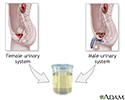Urine drug screen
Drug screen - urine
A urine drug screen is used to detect illegal and some prescription drugs in the urine.
How the Test is Performed
Before the test, you may be asked to remove all your clothes and wear a hospital gown. You will then be placed in a room where you have no access to your personal items or water. This is so you cannot dilute the sample, or use someone else's urine for the test.
This test involves collecting a "clean-catch" (midstream) urine sample:
- Wash your hands with soap and water. Dry your hands with a clean towel.
- Men and boys should wipe the head of the penis with a moist cloth or disposable towelette. Before cleaning, gently pull back (retract) the foreskin, if you have one.
- Women and girls need to wash the area between the lips of the vagina with soapy water and rinse well. Or, if instructed, use a disposable towelette to wipe the genital area.
- As you start to urinate, allow a small amount to fall into the toilet bowl. This clears the urethra of contaminants.
- Then, in the container you are given, catch about 1 to 2 ounces (30 to 60 milliliters) of urine. Remove the container from the urine stream.
- Give the container to the health care provider or assistant.
- Wash your hands again with soap and water.
The sample is then taken to the lab for evaluation.
How the Test will Feel
The test involves only normal urination.
Why the Test is Performed
The test is performed to detect the presence of illegal and some prescription drugs in your urine. Their presence may indicate that you recently used these drugs. Some drugs may remain in your system for several weeks, so the drug test needs to be interpreted carefully.
Normal Results
No drugs in the urine, unless you are taking medicines prescribed by your health care provider.
What Abnormal Results Mean
If the test result is positive, another test called gas-chromatography mass spectrometry (GC-MS) may be done to confirm the results. The GC-MS will help tell the difference between a false positive and a true positive.
In some cases, a positive test will be a false positive. This can result from interfering factors such as some foods, prescription medicines, and other drugs. Your provider will be aware of this possibility.
References
Bluth MH, Pincus MR, Abraham NZ. Toxicology and therapeutic drug monitoring. In: McPherson RA, Pincus MR, eds. Henry's Clinical Diagnosis and Management by Laboratory Methods. 24th ed. Philadelphia, PA: Elsevier; 2022:chap 24.
Breuner CC. Substance abuse. In: Kliegman RM, St. Geme JW, Blum NJ, Shah SS, Tasker RC, Wilson KM, eds. Nelson Textbook of Pediatrics. 21st ed. Philadelphia, PA: Elsevier; 2020:chap 140.
Nikolaides JK, Thompson TM. Opioids. In: Walls RM, ed. Rosen's Emergency Medicine: Concepts and Clinical Practice. 10th ed. Philadelphia, PA: Elsevier; 2023:chap 151.
Review Date: 1/2/2023



